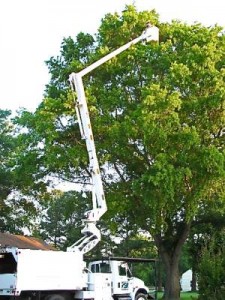 Every pruning cut causes an injury to your tree, therefore each cut should be made with an understanding of how the tree will respond to that injury. We generally perform mature tree pruning to improve light penetration to turf grass or to eliminate interference with a home or other structure. Our ISA Certified Arborists are formally trained to accomplish these pruning goals while minimizing injury to your tree. Improper cutting technique which damages the branch collar can lead to irreversible decline and decay in your trees. Our arborists do not wear spikes while pruning your trees, as this can be especially damaging to trunk tissue by opening pathways for insect and disease pathogens that may invade and kill your tree.
Every pruning cut causes an injury to your tree, therefore each cut should be made with an understanding of how the tree will respond to that injury. We generally perform mature tree pruning to improve light penetration to turf grass or to eliminate interference with a home or other structure. Our ISA Certified Arborists are formally trained to accomplish these pruning goals while minimizing injury to your tree. Improper cutting technique which damages the branch collar can lead to irreversible decline and decay in your trees. Our arborists do not wear spikes while pruning your trees, as this can be especially damaging to trunk tissue by opening pathways for insect and disease pathogens that may invade and kill your tree.
What Season Is Best for Tree Pruning?
The best time of year for tree pruning varies with the particular species. We always consider the species, wound closure response times, transmission periods of disease, cold hardiness, and seasonal flowering. It is also important to remember that the leaves are food making factories and the tree can be starved and severely stressed by the removal of too much live tissue. Having scientifically based knowledge about the species being pruned is essential to a successful tree pruning plan. Here’s a few basic guidelines for some common trees in Hampton Roads:
- Dead limbs can be pruned anytime of year.
- Crapemyrtles are best pruned during winter, they flower on new wood.
- The safest time to prune oaks is mid to late winter, oak wilt is a serious concern.
- Sweetgum, sycamore, blackgum, baldcypress can be pruned any season.
- It’s preferable to prune flowering cherries in late summer.
- Pines are best pruned in the spring.
Incorrect tree pruning techniques and poor timing will permanently damage your trees. If you’re unsure about how to care for your trees correctly, please call us. We’re always happy to talk about proper tree pruning. We can answer many questions over the phone or through email and we can schedule a consultation if needed.
